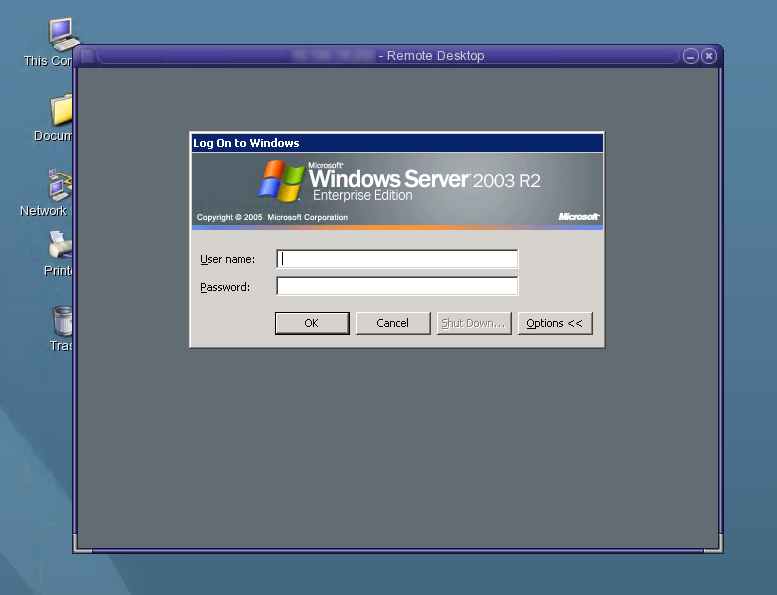This section describes how to start a Windows session on a Sun Ray Client or an Oracle Virtual Desktop Client. The Windows connector and the remote Windows server must be configured beforehand.
The uttsc command enables you to establish a remote connection with a Windows server through the connector. An alternative uttscwrap command is also provided for users that use JDS on Solaris.
Many of the functions provided by a local Windows desktop are provided with a Windows session on a client, including the ability to access USB devices connected directly to a Sun Ray Client using USB redirection.
Once the Windows connector has been configured, you can start a Windows session on a Sun Ray client from a Windows server.
Log in to a Sun Ray client.
Start a Windows session on a Windows server.
% /opt/SUNWuttsc/bin/uttsc
optionshostname.domainIf the Windows server is in the same domain as the Sun Ray client, you do not have to specify the domain name. However, if you prefer, you may specify the full IP address instead of
hostname.domain
Issuing the uttsc command with no options except the name or address of a Windows server displays a Windows session on the Sun Ray client, as shown in Figure 15.2, “Windows Connector (uttsc) Example”.
The default screen size is 640 x 480 pixels.
To display a session in full-screen mode or to modify it in
other ways, see the uttsc(1) man page.
Log in as UNIX userid user, enable 24-bit color, set
resolution to 1024x768, turn sound quality on high, and
connect to the Windows server 192.168.1.20:
uttsc -u user -A 24 -g 1024x768 -r sound:high 192.168.1.20
Log in as Unix userid user,
enable full screen,
enable 24-bit color, disables access to the RDP pull-down
menu, and connect to the Windows server at 192.168.1.20:
uttsc -u user -A 24 -m -b 192.168.1.20
Log in as Unix userid user, enable 24-bit color, set
resolution to 1024x768, enable sound quality to high, enable
2 factor authentication, and connect to the Windows server
at 192.168.1.20:
uttsc -u user -A 24 -g 1024x768 -r sound:high -r scard:on 192.168.1.20
Log in as Unix userid user, enable 24-bit color, set
resolution to 1024x768, enable sound quality to high, map
the home directory to Windows H: drive, and connect to the
Windows server at 192.168.1.20:
uttsc -uuser-A 24 -g 1024x768 -r sound:high -r disk:H=path192.168.1.20
Enable full screen session with smart card authentication
enabled and connect to the Windows server
windows_server:
uttsc -r scard:on -m windows_server
The Sun Java Desktop System (JDS) integration package for the
Solaris Operating System delivers a CLI called
uttscwrap, which improves integration of
the Windows connector with the JDS desktop on Solaris 10. The
JDS integration package is included in the
Supplemental folder of the Sun Ray Software
Media Pack.
Use uttscwrap when desktop or menu launchers are defined to launch either Windows sessions or Windows applications on various Windows systems.
uttscwrap provides a login dialog that
enables you to input credentials for password-based
authentication (username/domain/password).
The credentials can be saved through the dialog for subsequent
invocations. At the next launch, the dialog displays the
credentials.
uttscwrap is designed for credential caching for password-based authentication only. It cannot be used with smart card authentication. For smart card authentication, use the uttsc command.
Credentials are saved separately for each Windows server and application combination. This convention enables you to save different credentials in the following ways:
For different applications on the same server
For different applications on different servers
For different server sessions with no applications launched
Any new credentials saved for a server or application replace previously saved credentials.
To use the uttscwrap command, specify the same parameters as the uttsc command line.
Log in to a Sun Ray client.
Start a Windows session on a Windows system.
% /opt/SUNWuttscwrap/bin/uttscwrap
optionshostname.domainIf the Windows system is in the same domain as the Sun Ray desktop, you do not have to specify the domain name. However, if you prefer, you may specify the full IP address instead of
hostname.domain
This procedure describes how to lock a Windows session when a session moves away from a given Sun Ray Client.
Implementation of this feature relies on technology not available by default, and it uses non-public Sun Ray interfaces as well as the use of certain public Sun Ray interfaces for purposes other than their intended use. For these reasons, this feature is not provided as a supported feature.
A commonly used approach to implement session locking is to
send the lockscreen keystrokes to the Windows Session using
xvkbd, which is invoked by
utaction.
You can invoke the utaction command from an
Xsession.d or xinitrc.d
script as follows:
#!/bin/sh XVKBD=/usr/openwin/bin/xvkdb /opt/SUNWut/bin/utaction -d "$XVKBD -text 'Ml'" &
Because xvkbd is not available by default,
you should modify the XVKBD setting in the
example so that it correctly identifies the installation
location of xvkbd.
The keystroke sequence Ml activates the
Windows lock for Windows 2003/XP sessions. You might need to
substitute a different keystroke sequence for other Windows
versions.
To access the uttsc command directly, add the following entry to your PATH variable:
/opt/SUNWuttsc/bin, /opt/SUNWuttsc/sbin, /opt/SUNWuttscwrap/bin
The /opt/SUNWuttscwrap/bin path is required
only if you are using the JDS integration package.
No graphical user interface is available for the Windows connector at this time. However, you can set up a launcher to create a desktop icon or menu item to connect to the Windows session.
For details about how to set up launchers, consult the desktop documentation for your operating system.
